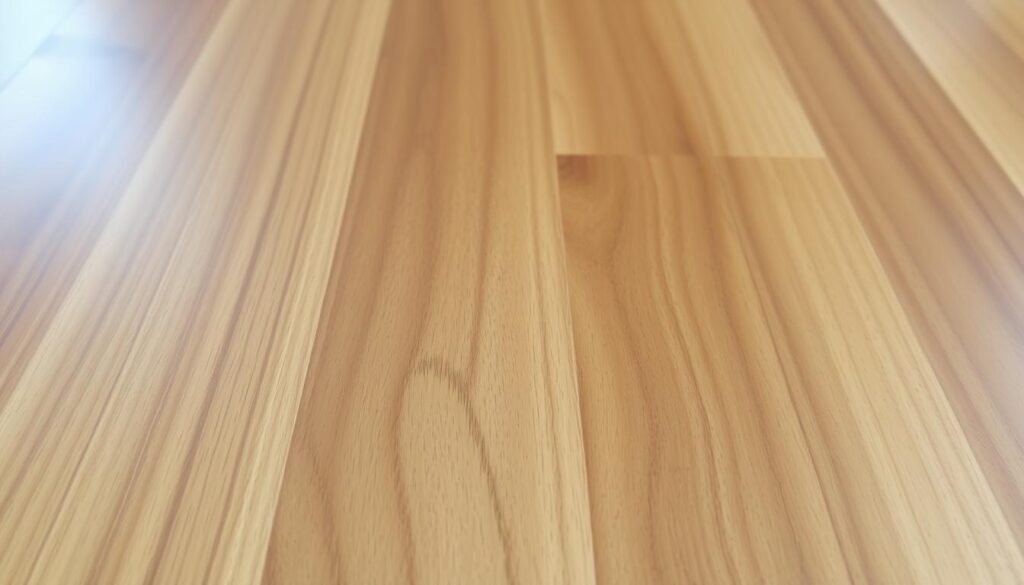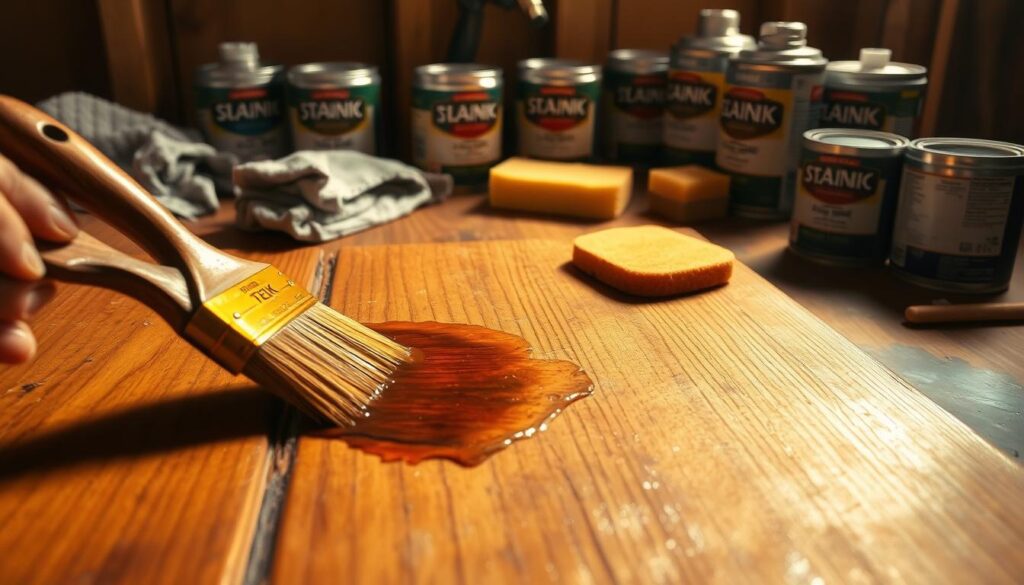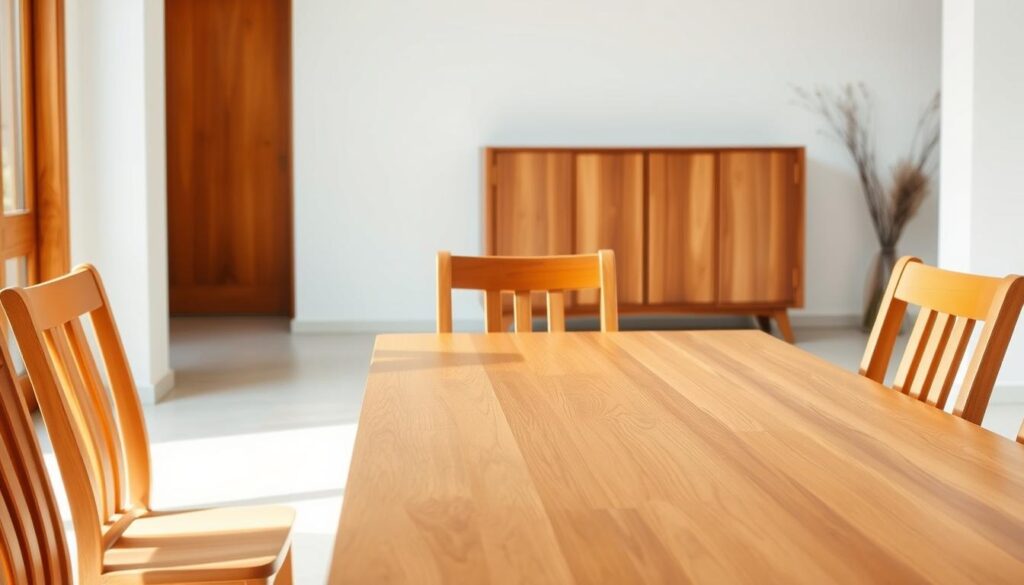Wondering if teak wood can be stained? Our comprehensive guide covers the pros and cons, as well as the best methods for can teak wood be stained.
Teak wood is a favorite for outdoor furniture because it lasts long and fights off rot and bugs. Many want to make it look even better by staining or finishing it. With the right steps and tools, you can get a beautiful and lasting finish.
Staining and finishing teak wood needs careful thought about its natural traits. Its high oil content makes staining tricky, but the right prep and methods can lead to a stunning look. This guide will cover the ups and downs of staining teak wood. We’ll talk about how to get the wood ready, apply stain, and keep the finish looking great.

Key Takeaways
- Teak wood can be stained, but it requires careful preparation and technique.
- Teak wood finishing is a great way to enhance the appearance of the wood.
- The high oil content in teak wood can make it difficult to stain.
- Proper preparation and maintenance are key to achieving a durable finish.
- Teak wood staining and finishing can be used to create a variety of different looks and styles.
- It is essential to consider the natural properties and characteristics of teak wood when staining or finishing.
Understanding Teak Wood Properties
Teak wood is known for its durability and beauty. It’s important to know how to stain it right. Teak wood is different from others because of its natural traits, oil, and grain.
Teak wood has a lot of oil, which can change how stain works. Its grain is tight and dense, affecting the look of stained wood.
Natural Characteristics of Teak
Teak wood resists rot, decay, and bugs well. It’s great for outdoor use. Its golden-brown color and unique grain make it perfect for furniture and decor.
Oil Content and Grain Structure
Teak wood has 30-50% oil, more than most woods. This high oil content makes staining tricky. The wood’s dense grain also hinders stain absorption.
Why Teak is Different from Other Woods
Teak wood stands out because of its special traits. Knowing its natural characteristics, oil, and grain helps in staining. This way, you can highlight its beauty and potential.
Can Teak Wood Be Stained: The Definitive Answer
Teak wood is a favorite for furniture and building because it’s tough and doesn’t rot or get eaten by bugs. Many wonder if can teak wood be stained. The answer is yes, but you need to think about the wood’s natural traits. Teak’s high oil content can change how stains work.
Staining teak wood means knowing its oil content affects stain absorption. Teak wood characteristics like grain and density also matter for the look. To get the color and finish you want, prepare the wood well and pick the right stain.
- Oil content: Teak wood’s high oil content can affect the stain’s absorption and drying time.
- Grain structure: The wood’s grain structure can impact the stain’s penetration and overall appearance.
- Surface preparation: Proper surface preparation, including cleaning and sanding, is essential for achieving a smooth and even finish.
Knowing can teak wood be stained and the special teak wood characteristics helps you get a stunning and lasting finish for your projects.
| Teak Wood Characteristics | Impact on Staining |
|---|---|
| High oil content | Affects stain absorption and drying time |
| Grain structure | Impacts stain penetration and appearance |
| Surface preparation | Essential for a smooth and even finish |
Preparing Teak Wood for Staining
Getting your teak wood preparation right is key for a top-notch finish. Before you stain the wood, clean and sand it well. This makes sure the stain goes on smoothly and evenly.
Start by cleaning the wood with a mild detergent and water. This gets rid of dirt and debris. Then, sand it to make the surface smooth. Use finer grits of sandpaper to get a perfect finish.
Video source from youtube
To stain your teak wood, you’ll need sandpaper, a clean cloth, and a brush. Make sure you work in a well-ventilated area and wear protective gear. With these steps and the right tools, your teak wood will look amazing.
Cleaning and Sanding Requirements
- Clean the surface using a mild detergent and water
- Sand the surface using progressively finer grits of sandpaper
- Use a clean cloth to wipe away any dust or debris
By following these steps and using the right techniques, you can ensure that your teak wood is properly prepared for staining and achieve a beautiful and long-lasting finish.
Best Types of Stains for Teak Wood
Choosing the right stain for teak wood is key. Teak wood stain options can seem endless. But, knowing the different stains helps you pick the best one. The top stains for teak wood bring out its natural beauty and protect it from the elements.
Popular best stains for teak wood include oil-based and water-based. Oil-based stains give a rich, lasting finish. Water-based stains are easier to clean up and have less smell. Think about durability, color, and how easy it is to maintain when picking a stain.
Here are some factors to consider when selecting a stain:
- Color: Pick a stain that matches the teak wood’s natural color.
- Durability: Think about how much protection you need, based on where and how you’ll use the wood.
- Maintenance: Consider how easy the stain is to care for and any special needs it might have.
By considering these points and picking the right stain, you can make your teak wood project look great and last long. Always follow the stain’s instructions and wear safety gear when applying it.
| Stain Type | Characteristics | Benefits |
|---|---|---|
| Oil-based | Rich, durable finish | Provides long-lasting protection |
| Water-based | Easier to clean up, less odor | Environmentally friendly, easy to apply |
Common Challenges When Staining Teak
Staining teak wood can be tricky because of its special properties. One big problem is its high oil content. This makes it hard for the stain to soak in evenly. This can cause teak wood staining problems, like uneven color and a dull finish.
Some common challenges when staining teak include:
- Oil content issues: Teak’s high oil content can make it difficult for the stain to adhere.
- Color absorption problems: The wood’s density and oil content can affect how well it absorbs the stain, leading to uneven color.
- Weather-related concerns: Teak is often used for outdoor furniture, which can be exposed to harsh weather conditions, causing the stain to fade or deteriorate.
To tackle these common staining issues, it’s key to prepare the teak wood surface right before staining. This means cleaning and sanding the wood. This removes dirt, oil, or debris that might mess with the staining process.
| Challenge | Solution |
|---|---|
| Oil content issues | Use a wood conditioner or a stain specifically designed for teak wood |
| Color absorption problems | Apply a test stain to a small, inconspicuous area to ensure even color absorption |
| Weather-related concerns | Use a waterproof sealant or a stain with UV protection to protect the wood from the elements |
Step-by-Step Teak Staining Process
The teak staining process has several steps for a professional finish. It’s key to follow a systematic approach for the best results when staining teak wood.
First, prepare the teak wood surface by cleaning and sanding. This makes the surface smooth for staining. It’s crucial for even stain application and to highlight the wood’s natural beauty.
Application Methods
There are different ways to apply stain to teak wood, like using a brush, roller, or cloth. The choice depends on the finish you want and the project size. A brush works well for small projects, while a roller is better for bigger areas.
Drying Times
Drying times are important in the staining process. Let the stain dry fully between coats, as the manufacturer suggests. This can take a few hours to several days, based on the stain type and environment.
Multiple Coat Considerations
When using multiple stain coats, think about the overall color and finish. Each coat must dry completely before adding the next. Limit the number of coats to avoid a thick, uneven finish.
| Stain Type | Drying Time | Number of Coats |
|---|---|---|
| Oil-based stain | 2-3 hours | 2-3 coats |
| Water-based stain | 1-2 hours | 1-2 coats |

Alternative Finishing Options for Teak
There are many ways to finish teak wood. These methods can make the wood look better and protect it from the weather. Some common choices include varnishes, polyurethanes, and oils.
Each teak wood finishing method has its own good and bad points. Varnishes give a strong, lasting finish but can make the wood look darker. Polyurethanes offer a flexible, water-resistant coat but don’t block UV rays as well. Oils soak into the wood for a natural, shiny-free look, but you might need to apply them more often.
Using alternative finishing options for teak wood has several benefits:
- It makes the wood last longer and look better
- It adds extra protection against the weather
- It makes the wood look more appealing
Exploring these teak wood finishing methods helps you find the right one for you. Whether you want to highlight the wood’s natural beauty or add extra protection, there’s a finish that fits your needs.
| Finishing Option | Advantages | Disadvantages |
|---|---|---|
| Varnish | Durable, hard finish | May darken the wood over time |
| Polyurethane | Flexible, water-resistant | May not provide UV protection |
| Oil | Natural, non-glossy finish | May require frequent applications |
Maintaining Stained Teak Wood
To keep your stained teak wood looking great, regular care is key. This means maintaining stained teak wood with the right cleaning and protection. A few easy steps can keep your teak wood beautiful and strong for many years.
Cleaning your teak wood regularly is vital. Start by sweeping or blowing off any dirt. Then, gently wash it with a mild soap. Always avoid harsh chemicals or rough cleaners that can harm the wood.
Regular Cleaning Procedures
- Daily: Sweep or blow off debris
- Weekly: Wash with a mild soap solution
- Monthly: Inspect for any damage or wear
It’s also crucial to refinish your stained teak wood now and then. This keeps the wood looking natural and protects it from the weather. How often you need to refinish depends on how much you use it and how much it’s exposed to the elements.
Refinishing Schedule
Refinish your stained teak wood every 2-3 years to keep it looking good and protected. This means applying a new stain and sealant. It helps keep the color vibrant and guards against damage.
| Refinishing Schedule | Frequency |
|---|---|
| Indoor teak wood | Every 3-5 years |
| Outdoor teak wood | Every 2-3 years |
By sticking to these easy maintenance tips, you can keep your stained teak wood in top shape. It will remain a stunning and durable part of your home or outdoor area.
Indoor vs Outdoor Teak Staining Considerations
Staining teak wood depends on where the furniture will go. Indoor vs outdoor teak staining needs different methods. Outdoor furniture faces harsh weather, like sun, rain, and cold, which can change the stain’s look and last.
Indoor furniture is safe from the weather but might get dusty or worn from people walking by. It’s key to pick the right stain and care for teak wood furniture maintenance to keep it looking good.
Here are some important things to think about for indoor and outdoor teak staining:
- Choose a stain that fits the place, thinking about UV protection and water resistance.
- Do what the maker says about applying and drying the stain for a nice finish.
- Check and care for the furniture often to stop damage and make it last longer.

Understanding the special needs of indoor and outdoor spaces helps keep your teak furniture looking great and lasting long. Whether for inside or outside, remember to focus on teak wood furniture maintenance. This way, you’ll get the most out of this beautiful and strong material.
| Environment | Challenges | Considerations |
|---|---|---|
| Indoor | Humidity, dust, human traffic | Choose a stain with low VOCs, regular cleaning and maintenance |
| Outdoor | Weather conditions, UV exposure | Choose a stain with UV resistance and water repellency, regular inspection and maintenance |
Troubleshooting Common Staining Issues
Working with teak wood means you might face staining problems. These can include uneven colors, stains not sticking, and mistakes during application. Knowing the causes and how to fix them is key.
Common issues include uneven colors, stains not sticking, and unwanted marks. Here are some steps to solve these problems:
- Check the wood for imperfections or debris that might affect the stain.
- Make sure to apply the stain evenly and follow the manufacturer’s instructions.
- Choose a high-quality stain made for teak wood.
By following these steps and using the right stain, you can fix common problems. Always test the stain on a small area first. This helps you spot any issues before applying it everywhere.
If you’re dealing with tough staining issues, get help from a pro or a wood finishing expert. With the right approach, you can make beautiful teak wood pieces that will last a long time.
Color Inconsistencies
Color issues are common when staining teak wood. Try adjusting the stain mix or applying a second coat. Make sure the wood is clean and ready for staining.
Stain Rejection Solutions
Stain rejection means the wood doesn’t take the stain evenly. Try a different stain or change how you apply it. Also, seal the wood well to protect it from damage.
Fixing Common Mistakes
Mistakes during staining can be a hassle, but they’re fixable. Use a stain remover or adjust the mix. Always work in a well-ventilated area and wear protective gear.
| Common Staining Issues | Solutions |
|---|---|
| Color Inconsistencies | Adjust stain mixture, apply second coat |
| Stain Rejection | Use different stain, adjust application process |
| Common Mistakes | Use stain remover, adjust stain mixture |
Professional vs DIY Teak Staining
Homeowners often face a choice between hiring a pro or doing it themselves when it comes to teak wood staining. Professional teak wood staining services offer top-notch results but cost more. DIY staining is cheaper but takes more time and effort.
Hiring a pro means getting access to special tools and knowing how to use them. They also offer a warranty, giving you peace of mind. But, it can be pricey, especially for big jobs.
DIY staining, on the other hand, saves you money on labor. With the right tools and materials, you can get great results. But, it takes more time and effort to do it yourself.
Here are some things to think about when choosing between professional and DIY teak staining:
- Cost: Professionals cost more but often do a better job.
- Time: DIY takes longer but lets you control the process.
- Expertise: Pros have the skills to get the job done right.
Choosing between professional and DIY staining depends on what you need and want. Weighing the pros and cons helps you make the best choice for your project.
| Option | Cost | Time | Expertise |
|---|---|---|---|
| Professional | Higher | Faster | Higher |
| DIY | Lower | Slower | Lower |
Conclusion
In this guide, we’ve delved into the world of staining teak wood. We’ve learned how to get a beautiful and lasting finish. We’ve covered everything from teak’s unique qualities to the staining process itself.
Teak wood needs special care because of its natural oils and grain. By preparing the surface right, choosing the best stains, and applying them carefully, you can make your teak projects look amazing. They will last for many years.
Staining teak wood requires patience and focus. With the right methods and care, your teak items will impress everyone for years. So, let’s celebrate teak’s natural beauty and enjoy making our spaces look great.
FAQ
Can teak wood be stained?
Yes, you can stain teak wood. But, you need to prepare it well and use the right techniques.
What are the natural characteristics of teak wood that affect staining?
Teak wood has lots of oil and a special grain. This makes staining tricky. The oil can push away water-based stains, and the grain can cause uneven colors.
What types of stains work best for teak wood?
Oil-based stains are better for teak wood. They get into the wood’s oils and give a smooth finish.
What are the common challenges when staining teak wood?
Staining teak wood can be hard. You might face oil issues, uneven color, and weather problems. The right prep and techniques can help.
How do I prepare teak wood for staining?
Preparing teak wood is key. Clean it, sand it, and use the right prep to get a smooth finish.
What is the step-by-step process for staining teak wood?
Staining involves applying the stain, letting it dry, and maybe adding more coats. This gets the color and finish right.
What are some alternative finishing options for teak wood besides staining?
You can also use varnishes, polyurethanes, or oils on teak wood. Each has its own benefits and drawbacks.
How do I maintain stained teak wood?
Keep stained teak wood clean and refinish it regularly. Use protective methods to keep the finish looking good.
Are there any differences between staining teak wood for indoor vs. outdoor use?
Yes, staining teak wood for indoors or outdoors has its own challenges. Outdoors, you face weather and UV light.
How can I troubleshoot common staining issues with teak wood?
Troubleshooting includes fixing color issues, stain rejection, and mistakes. There are many solutions and techniques to help.
Should I hire a professional or do a DIY teak staining project?
Whether to hire a pro or do it yourself depends on your skills and the project’s complexity. Think about what you want to achieve.
Read also : Invest in the Best Teak Wood Furniture for Your Home
